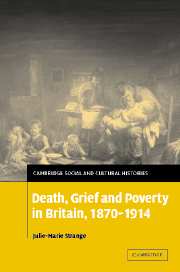Book contents
- Frontmatter
- Contents
- Acknowledgements
- List of abbreviations
- 1 Introduction: revisiting the Victorian and Edwardian celebration of death
- 2 Life, sickness and death
- 3 Caring for the corpse
- 4 The funeral
- 5 Only a pauper whom nobody owns: reassessing the pauper burial
- 6 Remembering the dead: the cemetery as a landscape for grief
- 7 Loss, memory and the management of feeling
- 8 Grieving for dead children
- 9 Epilogue: death, grief and the Great War
- Bibliography
- Index
9 - Epilogue: death, grief and the Great War
Published online by Cambridge University Press: 05 July 2009
- Frontmatter
- Contents
- Acknowledgements
- List of abbreviations
- 1 Introduction: revisiting the Victorian and Edwardian celebration of death
- 2 Life, sickness and death
- 3 Caring for the corpse
- 4 The funeral
- 5 Only a pauper whom nobody owns: reassessing the pauper burial
- 6 Remembering the dead: the cemetery as a landscape for grief
- 7 Loss, memory and the management of feeling
- 8 Grieving for dead children
- 9 Epilogue: death, grief and the Great War
- Bibliography
- Index
Summary
Much has been written concerning the impact of the Great War on cultures of death and grief. For many historians, the volume and horror of young men's deaths in foreign fields rendered the Victorian display of mourning inappropriate. In its place grew a subdued, silent and privatised culture of grief that persisted throughout most of the twentieth century. David Cannadine argued that this shift was for the better: responses to grief during the First World War overwhelmingly minimised national, material and religious difference to emphasise the universality of human experiences of loss, giving rise to a sincere and egalitarian culture of death. Others, notably Gorer and Ariès, interpreted the shift negatively, arguing that death was increasingly hidden from public view: people died in hospitals, funeral directors removed corpses to chapels of rest, and a decline in religious belief denied the bereaved a language of hope and reunion. Cultures of death were reduced to the embarrassed and speedy dispatch of the corpse whilst friends avoided mention of the death, preferring to send a mass-produced ‘With Sympathy’ card which required no personal input beyond a signature.
Contesting the status of the war as a hiatus in cultures of death, other commentators have emphasised the continuities between the nineteenth and twentieth centuries. In working-class burial custom, much remained the same until at least the Second World War. As Wilson and Levy noted in their call for burial reform in the 1930s, cultural habits were slow to change.
- Type
- Chapter
- Information
- Death, Grief and Poverty in Britain, 1870–1914 , pp. 263 - 273Publisher: Cambridge University PressPrint publication year: 2005



